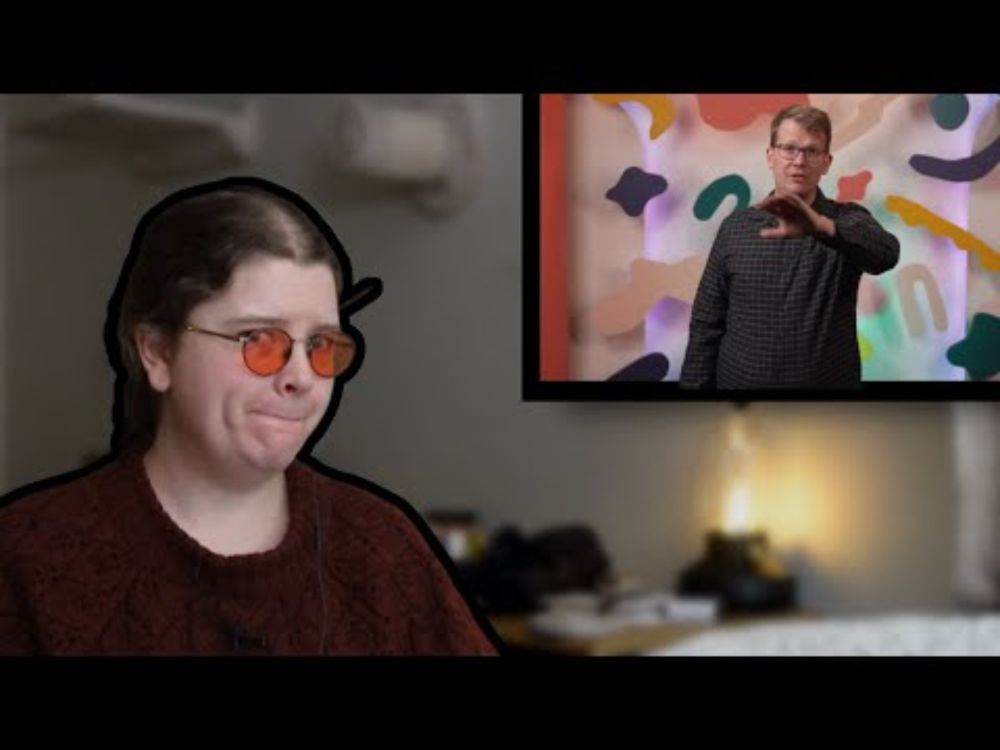I can't keep up, but here are three other bangers!
www.youtube.com/watch?v=yGsj...
www.youtube.com/watch?v=sHpG...
www.youtube.com/watch?v=5btQ...
Again, I'm a longtime fan of Hank Green and SciShow. Sharing these videos because it's so good to hear people talk about knitting THIS way.
19.09.2025 11:49 — 👍 3 🔁 0 💬 0 📌 0
YouTube video by Deborah Knits
Did Hank Green Just Mansplain Knitting?
Ooouuuuu here's another good response!
10.09.2025 08:48 — 👍 5 🔁 0 💬 1 📌 0
YouTube video by Kristine Vike
Scientist and Knitter reacts to SciShow's knitting video
Oooh, this is a very good response!!
07.09.2025 09:24 — 👍 8 🔁 0 💬 2 📌 0

@twiggyvlogs6441
Trial and error kind of is the foundation of science, we have a hypothesis, we test it, we work with it and we build on what we learnt. That's what knitters have been doing this whole time.
I love the increased visibility of knitting, I've been involved with some people researching it's applications in the architecture world which is really fantastic.
Its important to be careful with the tone of reporting around this. It can sometimes get very 'some old ladies were messing with string in a cave and then the physicists came and made the knitting into something proper!'.
There is a high level of technical understanding in crafting culture. When we minimise this we do both groups a disservice. Knitters have often been women and often been from backgrounds where they didn't have access to good formal education. This doesn't mean they were stupid or unable to understand what they were doing. We need to credit them but also, we need to involve knitters in the research and lots of them. If we don't engage with the crafts people we are leaving such a lot of amazing knowledge on the table.

@outfitmadeofawesome
I take a bit of issue with referring to the development of knitting as "trial and error". I am both a knitter and a (former) analytic philosopher, and I don't think this characterization is really fair to the history of knitting. Nor is it really consistent with the way we talk about other fields.
I understand the point you're making here: we lacked a mechanistic explanation for the behaviour of knitted materials until relatively recently. However, absence of a mechanistic understanding does not imply that all knitting patterns were developed through "trial and error", at least not as it this phrase is typically used. For instance, we do not currently have a complete mechanistic explanation for the pain-killing properties of acetaminophen. Nevertheless, we understand very well what acetaminophen *does*. When a pharmacist tells you to take an acetaminophen for your headache, she isn't just guessing or trying something out. We know very very much indeed about the effects and side-effects of acetaminophen, which we learned through observation, reflection, and inference from our observations. That's the skeleton of the scientific method.
Knitting patterns were developed in the same way. A knitter may not have understood the physics of a knit stitch or a yarn-over, but they understood very well what those action *did*. Designers were able to create complex patterns through inference from their previous observations. Knitting is no more an "art developed through trial and error" than engineering is. You do not need a complete mechanistic explanation of the functionality of the universe in order to do science. Lacking an understanding of the physics of a purl stitch doesn't mean that knitwear designers weren't doing something scientific. They didn't develop punch cards through trial and error, nor lacework, nor cables. This was through observation, reflection, and inference.

@NeptuneTart
"Perhaps knitting doesn't fill you to the brim with excitement--"
SPEAK FOR YOURSELF, GREEN.

@michaelajohn189
1:33 Actually, programming is a little like knitting!
Charles Babbage’s 1837 Analytical Engine, widely considered to be the first computer, was designed to use punch cards. Computers from the 1950s to 1970s famously continued to rely on punch cards to represent their 1/0 binary states. Why? It was actually inspired by an earlier invention, the Jacquard machine.
The Jacquard machine, invented in 1804, was a device that could be attached to weaving (and later knitting) machine looms to enable automatic patterning in a binary system. In weaving, the horizontal weft thread can either go above or below the warp threads, and different patterns of above or below will create fabrics with different qualities. In knitting, you can either switch colors, or do either a knit or purl stitch. Humans can do that on their own, but automation makes it much faster. The Jacquard machine used punch cards to denote one state or the other, so you could design whatever binary-based pattern you wanted and have a machine weave or knit it for you.
Charles Babbage took this concept and used it for his Analytical Engine design. Later, Ada Lovelace noted that using these punch cards, you could direct the Engine to do specific tasks— a feat that she is now recognized as the first computer programmer for. And both of those achievements owe themselves to innovations in textile production!
But what has knitters sounding off in the comments are the descriptions of knitting as "more of an art than science", "intuition", "trial and error", and "like programming" (rather than the other way around).
I'll include some of my favourite comments.
05.09.2025 13:18 — 👍 5 🔁 0 💬 1 📌 0
Hank talks about how common knit fabric is, while a photo of shirts made of woven fabrics are shown.
Then he talks about how stockinette is stitch made out of knit stitches on the front side, illustrated with a photo of reverse stockinette. 🙈
05.09.2025 13:03 — 👍 2 🔁 0 💬 1 📌 0
YouTube video by SciShow
Physicists Don’t Understand Why Knitting Works
Oh my!! The comment section!! 😂 I love us knitters!
To quote one of them: "I felt delighted and slighted at the same time."
(I've been fans of Hank Green and SciShow for ages, so this is just friendly fire)
05.09.2025 12:52 — 👍 13 🔁 0 💬 2 📌 0
Yeah😄 I only found out AFTER that the recommended Anchor Tapestry Wool was considerably thinner when the pattern was made. 🙈
18.03.2025 10:31 — 👍 1 🔁 0 💬 0 📌 0

Progress on my embroidery project, stage 1.

Progress on my embroidery project, stage 2.

Progress on my embroidery project, stage 3.

Progress on my embroidery project, stage 4.
I have discovered a new hobby - this only happens, like, once a decade!
I haven't been this sucked into something since I first discovered stranded colourwork knitting.
18.03.2025 08:59 — 👍 56 🔁 1 💬 3 📌 0
Before you begin your next 🧶 project, be sure to set yourself up for success:
1 Print your pattern & mark your size.
2 Ensure you have enough yarn. Get more if need be.
3 Practice frowning at those who ask you to "knit me a jumper"
4 Dig holes in your garden for the bodies of those who keep asking.
07.02.2025 11:37 — 👍 209 🔁 24 💬 2 📌 1
She is the babiest ❤️
26.01.2025 18:30 — 👍 0 🔁 0 💬 0 📌 0

Me knitting in my living room, while my mini schnauzer rests her head on my shoulder.
Don't get a mini schnauzer if you don't want this while you knit.🥰
26.01.2025 15:39 — 👍 168 🔁 2 💬 9 📌 1

Hiii! It's so nice to see you all here. That I'm not the only one who's fed up with Meta deciding what we do and don't see, and the political direction they're heading!
To new people: I make Scandi inspired knitting patterns with a modern twist✨ and I host a knitting podcast on YouTube, since 2016.
26.01.2025 15:19 — 👍 105 🔁 0 💬 4 📌 0
Aka ArcticKnitting
Looking for all the yarnies, someone told me they’re somewhere in this app
📍Creator of bespoke attire for hounds and doggos since 2022 🪡🧵🧶✨
📍Handmade in Yorkshire 🌿🐾
❌ Anti-racing
https://linktr.ee/brackenandpaws
🌘 Moody, Gothic yarn for your fiber-loving soul.
🌕 Knitting, crochet & other creative rabbit holes.
🌒 www.VoolenvineYarns.com
Knitting and sewing things for myself, friends and family
Knitwear designer
🧶
Find me as Yarnflakes on
ravelry - youtube
https://campsite.bio/yarnflakes
www.thepluckyknitter.com
Hand-Dyed Yarn… Artisan Colors… Curated Fibers...
https://linktr.ee/thepluckyknitter
Knitting. Wool. Books. Food. Cats.
Posting about my knits, your knits, and iconic knits | #Knitspo | Knitting is my therapy | Knitting as a radical act | Manchester, UK | **My designs here**➡️ https://linktr.ee/OhKnitKnitting
Designer of knitwear, interiors, gardens, life.
Cat mom to George, the best cat.
Etsy & Ravelry for my knitting patterns.
Poshmark & YouTube.
Published in Interweave Knits, Knitters, Interweave Felt, Best of Interweave, Color Style, Knitted Gifts.
craft is for everyone!
bloots by @rosieatlarge
Knitting Patterns 🐑 Workshops
Yarn 🐑YouTube 🐑 Online Courses
🧶 Love of Lace Knitting FB group 🧶
🇳🇴 Norwegian living in the UK 🇪🇺 www.yarnaddict.co.uk
Writing books and designing knitwear in Kintyre. 🧶📚
knitty.com : the free online knitting + fibercraft mag, est. 2002. Amy, editor (she): est. quite a bit before that. 🧶
Free thanks to our Patrons!
guild.knitty.com
#knitting #crochet #AuDHD #science #compassion #CDN #hamont 🇨🇦
Perpetually covid vaxxed💉
Sourcing 🦋 Eco-friendly,
⚖️ Ethical,
♥️ Scrumptious 🧶 Yarns
for you since 2010!
🌎 Worldwide shipping.
https://knitwithatitude.com
Wool. Making and researching.
rosapomar.com
Knitwear designer
Romantic knits from the north
Find my patterns on Ravelry:
https://www.ravelry.com/designers/anna-johanna
Dr. MRO. Literary Historian. Public scholar, activist & small biz owner who dyes yarn inspired by Black/brwn premodern figures.
WOC: product of Black & brown love. Gif lover. Racist magnet. Abolitionist. Not Eddie Murphy. She/hers
www.RepublicOfYarnia.com












